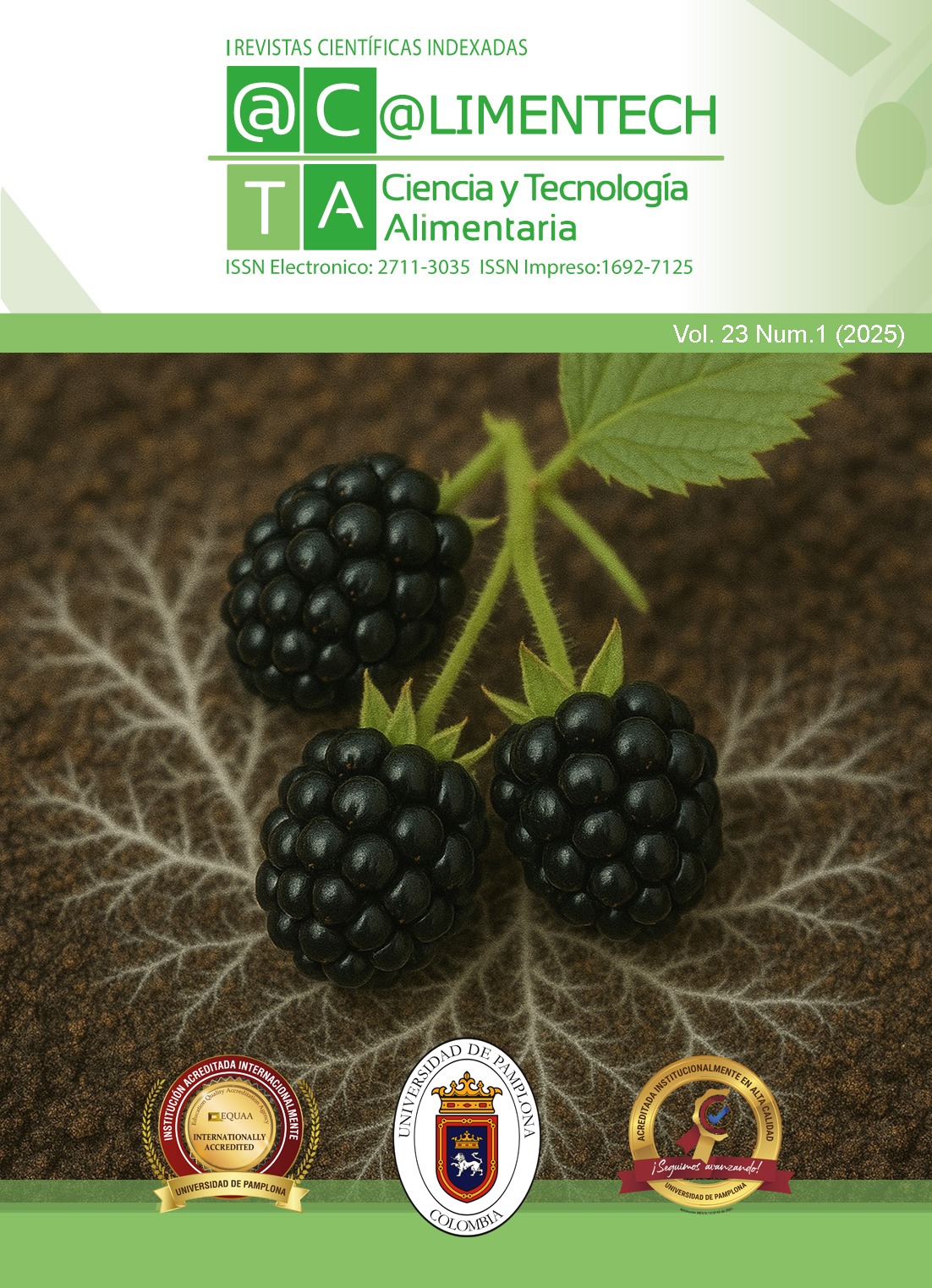Influence of three different strains of yeasts on the microbiological and physicochemical profile in the production of a watermelon liqueur (Citrullus lanatus).
DOI:
https://doi.org/10.24054/ssmgg339Keywords:
fermentation, liquor, watermelon, yeastAbstract
This research presents the behaviour of three different yeast strains (Saccharomyces cerevisiae, Saccharomyces bayanus and Saccharomyces cerevisiae x Saccharomyces bayanus) during the fermentation process used to produce watermelon liquor. Based on the evaluation of aspects such as fermentation speed, the amount of alcohol produced and the quality of the final product obtained, it was determined which of the three strains was the most efficient. Three fermentations were carried out using one type of yeast in each one, under controlled conditions of temperature and pH. Microbiological and physicochemical tests were carried out to determine the stability of the watermelon liquor. According to the results obtained, it was determined that the yeast sacharomyces cerevisiae x bayanus, presented pH results with a value of 4.3 on day 1 and 4.34 on day 7; 17.0 Brix degrees on day 1 and 17.1 on day 7; the microbiological tests did not present pathogenic microorganisms or different from the yeasts and with respect to the fermentation curve, day 1 presented 84'000.000 spores and day 7 38'000.000 spores. According to the previous results, this yeast was the most efficient, in terms of stability of the final product and quality of the production process.
Downloads
References
Bevilacqua, A., Petruzzi, L., Arevalo-Villena, M., Kandylis, P., and Nisiotou, A. (2022). Editorial: Wine Microbiology: Current Trends and Approaches. Frontiers in Microbiology, 13, 873980. https://doi.org/10.3389/fmicb.2022.873980.
Bonilla R., María J. y Vera R., José M. (2019). Características fisicoquímicas y colorimétricas de licores de cacao obtenidos de los clones TCS 06, FEAR 5 Y FSV 41. Revista @limentech, Ciencia y Tecnología Alimentaria. ISSN 1692-7125. Vol.17 N 1. Pp:40-59. https://doi.org/10.24054/limentech.v17i1.333.
Comitini, F., Agarbati, A., Canonico, L., & Ciani, M. (2021). Yeast interactions and molecular mechanisms in wine fermentation: A comprehensive review. International Journal of Molecular Sciences. MDPI. https://doi.org/10.3390/ijms22147754
Fernández-Pérez, R., González-Lázaro, M., Reda, M., Tenorio, C., & Ruiz-Larrea, F. (2018). Resistencia al etanol de bacterias lácticas enológicas; formación de biofilm y acción antimicrobiana de la nisina. XII Congreso de los Grupos de Investigación Enológica (GIENOL 2013). Nuevas perspectivas en investigación vitivinícola, celebrado en Madrid del 18 al 21 de junio de 2013.
Fuentes, L. F. Q., Pinilla, M. G., & Mendoza, L. J. (2014). Estandarización de la fase de fermentación “fase I” en la obtención de un licor de mandarina utilizando levadura “Saccharomyces cerevisiae”. Publicaciones e Investigación, 8, 139-149.
Lemus Martínez, S. (2020). Optimización de un proceso de fermentación artesanal para elaboración de vinagre y estudio del inoculo empleado (Madre del vinagre). Trabajo de grado Lic. en Alimentos. Facultad de Ingeniería. Universidad Autónoma de Puebla. México.
Mas, A., Beltran, G., & Torija, M. J. (2020). Microbiological control of alcoholic fermentation. Ecocycles. European Ecocycles Society. https://doi.org/10.19040/ecocycles.v6i2.181
Octiara, E., Meliala, C. P., & Sikumbang, L. (2023). Antibacterial Activity of Durian Peel Ethanol Extract (Durio zibethinus Murr.) against Streptococcus mutans and Enterococcus faecalis. Biomedical and Pharmacology Journal, 16(2), 877–883. https://doi.org/10.13005/bpj/2670
Parapouli, M., Vasileiadis, A., Afendra, A. S., & Hatziloukas, E. (2020). Saccharomyces cerevisiae and its industrial applications. AIMS Microbiology,6(1),1-32.
Pineda-Zambrano, M. C., Pineda, D., Labarca, J. L. & González-García, H. (2020). Caracterización y comportamiento biológico de una cepa nativa de Trichoderma harzianum Rifai del Sur del Lago de Maracaibo, Venezuela. Ciencia y Tecnología Agropecuaria, 5(1), 9-15. https://ojs.unipamplona.edu.co/index.php/rcyta/article/view/788/1132.
Rodríguez Cepeda, R., & Álvarez Suarez, N. Y. (2021). Actividad antimicrobiana del extracto hidroalcohólico de Caléndula officinalis L. Revista Ion, 34(1), 97-110.
Seo SO, Park SK, Jung SC, Ryu CM, Kim JS. Anti-Contamination Strategies for Yeast Fermentations. Microorganisms. 2020 Feb 18;8(2):274. https://doi.org/10.3390/microorganisms8020274. PMID: 32085437; PMCID: PMC7074673.
Troya Guerrero, G., & Pino Meléndez, V. E. (2023). Microbiota asociada a plantaciones agroforestales de cacao y su impacto en la tolerancia al estrés abiótico. Ciencia y Tecnología Agropecuaria, 8(1), 24–33. https://doi.org/10.24054/cyta.v8i1.2877.
Vanidze, M., Kharadze, M., Djafaridze, I., Kalandia, G., & Kalandia, A. (2019). Phenolic compounds and their variation with respect to wine fermentation method in Georgian Autochthonal grape Ojaleshi. Journal of Biotechnology, 305, S63. https://doi.org/10.1016/j.jbiotec.2019.05.221
Vásquez Cortez, L. H., Cevallos Castillo, C. A., Uvidia Vélez, M. V., Segobia Muñoz, S. A., y Plua Montiel, J. A. (2025). Evaluación de métodos fermentativos de cacao Nacional y CCN51 induciendo microorganismos en yute y cajas Rohan para mejora organoléptico. Luna Azul, (60). https://doi.org/10.17151/luaz.2025.60.10
Vera Romero José Manuel; Castellanos Suarez Laura Johana. (2022). Evaluación de características colorimétricas y fisicoquímicas en licores de cacao variedades Santander Revista @limentech, Ciencia y Tecnología Alimentaria. ISSN Impreso 1692-7125 ISSN Electrónico 2711-3035. Vol. 20 N° 1. Pp: 66 - 76. https://doi.org/10.24054/limentech.v20i1.3179
Vicente, J., Ruiz, J., Belda, I., Benito-Vázquez, I., Marquina, D., Calderón, F., Benito, S. (2020). The genus metschnikowia in enology. Microorganisms. MDPI AG. https://doi.org/10.3390/microorganisms8071038
Downloads
Published
Issue
Section
License
Copyright (c) 2025 @limentech, Ciencia y Tecnología Alimentaria

This work is licensed under a Creative Commons Attribution-NonCommercial 4.0 International License.








